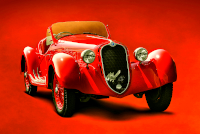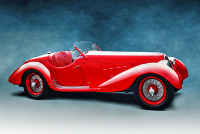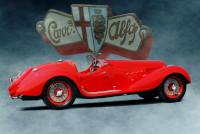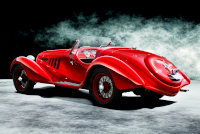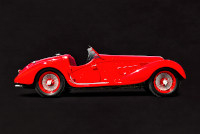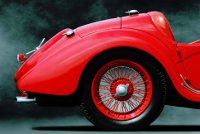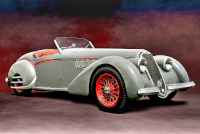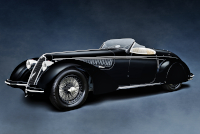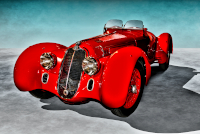Location:
Radnor Hunt Concours d'Elegance, 2007
Owner: Simeone Foundation Automotive Museum | Philadelphia, Pennsylvania
Prologue:
Often referenced as the Carrozzeria Alfa design, the 8C 2900A Mille Miglia bears a strong Touring influence, though not of race-ready intent as demonstrated by the 8C 2900B Mille Miglia Touring Spider. This outfit is for road use, and found some popularity on the motor show circuit, counterpoint to the cycle-fendered Botticella configuration.
And yet the 2900A is potent in any form, more so than the road-going 2900B. Only those five race-prepared 2900B cars—chassis #412030 through #412034—advance the concept.
What we see here is one of eight 2900A Mille Miglia cars with roadster coachwork completed by the Alfa Romeo factory, what Simon Moore terms the 'Alfa Spider.' The car raced as chassis #412003 before returning to the factory in 1937 for its roadgoing coachwork, where the factory re-stamped the chassis as #412015.
Looking back at 2007, I have tried to add and update images that at the very least provide color and variety. At the time, I had just received Alain de Cadenet's "Victory by Design" Alfa Romeo video, which outlines part of the 8C 2900A story, though inaccurately in terms of the role of the Alfa Spider and how many survive. But having seen this car in film, chassis #412015 seemed extraordinary to see in the flesh.
Although I shot with different ideas at the time, some of these old photographs became halfway decent images. Now with a copy of Moore's revised "The Immortal 2.9," I'm surprised to see that, by pure chance, the only known pre-war photograph of #412015 looks oddly similar to the first quarter shot shown here. In any case, I've simply worked with what I have available, and with the car nearby at the Simeone Foundation, might yet finish a more proper survey. For the time being, however, our retrospective is rather historical in and of itself.
- - - - - - - - - -
► Image Source: Nikon D200 (10.2 MP)
References:
- Automobile Quarterly, Volume 11, Number 2, Second Quarter 1973, "The Immortal Alfa Romeo Two-Nine" by Peter Hull and Simon Moore, The Kutztown Publishing Company, Inc., Kutztown, PA, page 179-181
- Moore, Simon. "The Immortal 2.9: Alfa Romeo 8C2900, Revised Edition" Parkside Publications, Inc., Seattle, WA. 2008, pages 87, 89, 121, 143-148, 446, 450, 458, 461, and others
- "Victory by Design" by Alain de Cadenet and Tony Maylam, directed by Tony Maylam, January 2004
- Simeone Foundation Automotive Museum: Read a nice account of chassis #412015's history.
- Grand Prix History: A wonderful site with detailed information and historic photos.
- UltimateCarPage: Information and photos of Simon Moore's chassis #412007, by Wouter Melissen, August 12, 2011.
The earlier 2900A looks the diminutive of the 2900B, but among the lot of road cars is racing-derived, not merely named for past Mille Miglia success, but aimed at the 1936 title. As Automobile Quarterly explain, the thinly veiled guise of 8C Monza Grand Prix cars worked over for two-seat sports car racing no longer pass sporting regulation, and the new 6C 2300 touring cars are simply inadequate. Hence the Two-Nine.
Construction of the first five chassis begins in 1935, and the 2900 uses as its foundation the 1935 8C Grand Prix chassis, including its suspension. Alfa prepare this car, then stamped as chassis #412003, for the 1936 Mille Miglia, featuring a stocky racing body with a tapered tail, twin windscreens, and cycle fenders. Cars of this configuration are termed, "Botticella," or cask cars, for their barrel-shaped fuselages. Along with mechanic Giuseppe Meazza, Nino Farina drives #412003 to second place in 1936. Alfa Romeo retain the car for works racing through 1937, when Farina again drives to second place in the Mille Miglia. Carlo Pintacuda wins in both of these years, the race being a specialty of his.
Overall, the 2900A dominates in patria. In 1936, the three Mille Miglia entrants finish first, second, and third, besting Clemente Biondetti in a 3.2-litre 8C Grand Prix that has been disguised in some roadworthy manner (much like the earlier 8C Monzas). Pintacuda also sets a new average speed record of 74.57 mph. The 2900A cadre compete throughout Europe in '36 and '37, winning at Spa Francorchamps in the Belgian 24 Hours, (quite the cherished victory among sports cars of any vintage, but somewhat overlooked when the badge reads 'Alfa,' in deference to the Mille Miglia).
Apart from the racing schedule, Alfa Romeo prepare some number of 8C 2900A chassis for the motor show circuit with aluminum coachwork inspired by the designs of Carrozzeria Touring, and probably guided by the coachbuilder's own talent. AQ note that, in 1936, Italy enter into war in Ethiopia, and so domestic auto production drop off in favor of aero motors. Total 1936 automotive production consists of just ten chassis. So in this context it makes sense that Alfa purpose race cars for the motor show circuit, and vice versa.
Farina's car, chassis #412003, receives Alfa spider coachwork in 1937, along with a new chassis number, #412015; this is the latest of all 8C 2900A numbers, and overlaps with the Corto Touring Spider whose production begins with #412011. In this case, #412015 is not a later chassis, being that it was originally #412003, merely an unusally high chassis number for the first series 2.9.
After Racing: 8C 2900 #412015 Discovery and Restoration
While originally built as a Botticella racer in 1936, the car receives its first road registration on October 5, 1937, held by the Alfa Romeo factory. A series of Italian and Sicilian owners follow, among whom Michele Sanguinetti is notable. He lends #412015 to Pietro Ghersi, who drives the car is at least two post-war races: the 1947 San Remo Gran Prix (3rd place), and the 1947 Circuito delle Casine in Firenze (DNF).
#412015 later moves to Sicily, whence George Gath, described vaguely as an ex-pat living in Europe, exports the Alfa Romeo to Argentina. Moore writes, "In Argentina, the car was sold to the young son of a millionaire banker named Ernesto Tornquist." He races the car in local events until 1952. Ernesto later assumes leadership of his family's bank and passes the Alfa to his own son.
Dr. Frederick Simeone now enters the story, as he is keen to track down historically significant racing Alfas, and through an intermediary persuades the younger Tornquist to part with the car. At this point, the car and its motor are separate, and acquiring the latter from its owner, Lucio Bollaert, requires more time and money than the former.
Dr. Simeone writes, "My Argentina contact was Hector Mendizabal, with whom I had corresponded through Ben Moser. They had found an old Kissel touring car in Argentina and did not know what to do with it. I arranged for us to donate it to the Kissel museum in Hartford, Wisconsin, where it still lives. Through these connections began a search for Senõr Tornquist. Now a hermit, he had the car in his shed, protected from the elements but not the pigeons, and when first examined, we saw it covered with, and perhaps protected by, pigeon droppings.
Hector called me excitedly when he found it. It was, however, in rough shape, though complete with one major exception, the engine was missing! When we brought the car into light, a metal shell covered the front cowl. They chopped the rear fenders. The front fenders were off and lying in a corner. The rest of the car, including the hood, body, doors, rear spare cover, and rear body section, were intact. The entire chassis, suspension, transaxle, and dash, except for one instrument, were also intact. The upholstery was in superb condition, and, in fact, it still sports one of its original pocketed door panels."
Fred Simoene brings the complete set to Philadelphia in 1984. He sends the motor to Jim Stokes in England for reconditioning, while David L. George manages the chassis restoration and finishing at home. Dr. Simeone notes that, "during restoration, David discovered the remnants of the stanchions for the cycle fenders it wore when it was in botticella form," which verifies the car's original racing form as chassis #412003. Simon Moore also notes that the team copies a few missing components from his own car, #412007.
Full restoration finishes in 1989, and Dr. Simeone takes the car back to Italy that year to run the Mille Miglia. Today, the car is a remarkably original A-specification 2.9.
At present, I believe only one 2900A Botticella exists (#412006), though ironically, this car was originally an Alfa Spider, now wearing a beautifully fabricated botticella body built by Paul Grist in the 1990s. There remain three Alfa Spiders, two of which are original—this car and the achingly beautiful two-tone car of marque specialist Simon Moore (#412007). The third, the other late-model 8C 2900A spider (#412013), lost its body for some time, but received new coachwork in 2001.
Motor: 2,905 cc (177.27 cubic inch) straight 8-cylinder, alloy block, fixed aluminum hemi-head | 68 mm x 100 mm | 6.5:1 compression
Chassis #412015 uses motor #422003, which matches the car's original chassis number, when it was the Botticella racing car of Giuseppe Farina.
The 2900A motor is a derivation of the 10-bearing Grand Prix motor first developed in 1932 as a 2.6-litre unit, enlarged in 1934 to 2.9 litres. The comparable 1935 Grand Prix car uses a much larger 3.8-litre motor with 7.1:1 compression. This smaller sports-racing unit is detuned to 6.5:1, which still exceeds the less-powerful second series 8C 2900B at 5.75:1.
Valvetrain: DOHC, 2 valves per cylinder, gear-driven via a central mechanism between each 4-cylinder block
Aspiration: twin Weber BS42 carburetors with twin Roots-type superchargers, each of which feeds one 4-cylinder block
Power: 220 bhp at 5,300 rpm, or a base of 190 bhp
Drivetrain: 4-speed gearbox in transaxle rear-wheel drive layout
Front Suspension: independent trailing links with coil springs over hydraulic dampers
Rear Suspension: independent swing axle on transverse semi-elliptic leaf springs with radius arms for location and both hydraulic and friction dampers
Alfa derived this rear suspension set-up from the 1935-36 8C Grand Pix cars, shared only on the 2900 with its transaxle layout.
Architecture: steel ladder-frame chassis with factory aluminum coachwork
Simon Moore writes, "Recent analysis of 412007's chassis frame has shown that this car (and therefore probably all the 1936 botticellas) was made from high grade chrome-molybdenum steel, in line with Alfa spec 2E, the same as the Tipo C frame. This is in contrast to the nickel-chrome steel used for the 8C 2300... Later 8C 2900B frames were made from high quality mild steel, not the special steel used for the race cars.
Kerb Weight: 852.75 kg (1,880 lbs)
This estimated weight figure pertains to the chassis as prepared with race-driven Boticella coachwork, and not the road car depicted here. This lightweight figure is just slightly more than a 1935 8C Grand Prix car, and perhaps 220 lbs off the fully laden weight of the Paris show car, which might weigh no less than 2,100 lbs.
Wheelbase: 2750 mm (108.3 inches)
Top Speed: 230 km/h (about 140 mph)
Etymology:
'8C 2900' refers to the motor, an 8-cylinder of 2.9 litre displacement. The 'A' designation refers to the first version of the 2900's development program, which begins in 1935, aimed directly at auto racing. 'Mille Miglia Spider' refers to this car's preparation in consecutive Mille Miglia contests between 1936 and 1937, when it ran as a true Botticella spider (a "cask car" with cycle fenders).
Figures:
Of the 51 recognized 8C 2900 chassis, Simon Moore lists eight as original 2900A Alfa Spider cars. The chassis numbers are difficult to parse due to renumbering, as in the case that #412003 later becomes #412015.
The first six of the eight known Alfa Spiders are original spiders from birth, all built from 1935-36; they are #412003, #412005, #412006, #412007, #412008, and #412013.
The last two Alfa Spiders begin life as Botticella race cars before the factory rebodies and renumbers them in 1937. First, Alfa Romeo rebody chassis #412005 and renumber the car as #412013, the same number as the last first-series Alfa Spider noted above; these are two different cars. Next, Alfa Romeo rebody a distinct Botticella car with chassis #412003, though different than the original Alfa Spider noted above, and renumber the car as #412015.
Confusing, but Simon Moore suggests that Alfa Romeo do use #412003 twice, once for a Botticella race car and once for an Alfa Spider. Moreover, he notes that the latter car is probably the car exhibited at the 1935 Paris Salon as this is the first of the series and the only Alfa Spider built in 1935.
But this numbering fiasco explains why, in "Victory by Design," Alain de Cadenet suggests that the red Simeone car is the Paris Salon car. Chassis #412015 was originally -003, but the other -003, the Botticella, and not the Paris spider. Period photos confirm as much, because the coachwork of the 1935-36 Alfa Spiders is different from the last two 1937 cars.
This other -003 car that appears at the Paris Salon soon loses its motor show coachwork and returns to race in the Mille Miglia as a Botticella, which de Cadenet mentions. However, that car was unfortunately lost. The car shown here, #412015, though a rechristening of the original -003 Botticella, has always looked exactly as we see it today since 1937.
According to Automobile Quarterly, Alfa complete only ten total chassis in 1936, of which five are 8C 2900A cars. Industry focuses on war efforts owing to conflict in Ethiopia, leaving resources scarce for luxury and sports car production.
Moore provides a similar story for 1937 as the Touring design takes shape, writing, "I believe that two Touring spiders were built by late 1937 (#412011 and #412014) so at the end of the year they had reached chassis number 15 (#412015) but had actually only built ten cars. It must be remembered that, as a state-owned company Alfa Romeo were concentrating on military vehicles and aero engine manufacture at this time, in support of Mussolini's wars in Africa."
From all of this mess, we conclude that there survive today three Alfa Spiders, two of which are original—this car and Simon Moore's #412007. The third, #412013, lost its original spider body, but received new coachwork in 2001.
Carrozzeria Alfa: Touring Influence in Alfa Romeo's Factory Design
The Simeone Museum notes that the shape and the detailing of this spider body take many cues from designs penned by Carrozzeria Touring, and that in this case the arrangement is largely one of borrowed talent without citation. Compare the 2900A to its more modest 2300 predecessors by Touring, or to its more muscular 2900B cousin, and the similarities are evident. Thus, the Carrozzeria Alfa badge is mere legerdemain, and most classic era fans would recognize the work of Touring even if it is not printed on the body.
Of that beautiful coachwork, there is fine delicacy in the overall shape, and lovely contrapose in the formal elements. The front fenders are both flowing and perky, well rounded in profile, but thin and drop-like in perspective. From the tail, the rear deck and integrated haunches hint at the 2900B's powerfully elegant shape, and yet the nose is comparatively trim, with less aerodynamic influence. For its prettiness, the car would be lovely as a scale model, (particularly Moore's #412007), a perfect representation of classic era thinking with hints of the aerodynamic revolution soon to come. But then matching these proportions in miniature would be devilishly difficult.
Mixed Bonnet: Combination 8C 2900A Louvres and Vents
Somewhat whimsical, the bonnet sides feature both traditional cut louvres and manual vents. The combination might seem busy, but oddly enough adds to the car's fascination. Similarly, the panel sweep follows a traditional French motif, diving to a sharp point behind the door on the flank. Then the return line waves up gracefully over the rear fender, creating a concentric seam around the skirts and down the edges of the rear deck that absolutely does not need to be there. But it is brilliant.
Alfa Adaptations: Slight Revisions to the Carrozzeria Alfa Design
From its 1937 rebirth at the Alfa Romeo factory—then changing chassis numbers from #412003 to #412015—this Alfa Spider has used a red-on-red livery. For comparison, look up Simon Moore's two-tone 8C 2900A with its marvelous compound folds throughout the tail. Moores car, chassis #412007, wears elegant red umber and cream bicolor paint, one of the prettiest roadsters of any make or vintage.
Moore notes that the final two Alfa Spiders, #412013 and #412015, receive revised coachwork from the factory. The grille cowl is of the slotted design with kidney-shaped vents, familiar to the Monza and the later 8C 2900B, and sits slightly forward compared to the original. Also key to the updates, the filler cap moves inside the grille shroud on the later car.
The running gear loses its thin chrome binding and does without mounted tail lights. There appears to be a slight difference in the curvature of the rear skirts, which on #412015 appear a bit longer and less rounded than on #412007, but this difference might also be a function of the handbuilt process. Still, #412007 appears a bit more curvateous
Less evident, #412015 does without an extra chrome piece along the lower edge of the doors, but adds trafficators to the bulkhead. Moreover, the solid red cloak on #412015 smooths over much of the intricacy and creates a lean profile. In this regard, I have long felt that Moore's #412007 is one of the prettiest classic roadsters in the world, but for all its similarity I do not feel quite the same way about #412015. The two cars are the same model, but there are very many differences between them.
That and color—we can't underestimate how color drives artistic preference. And in this respect, Dr. Simeone's #412015 could be seen as the best expression of an original 8C 2900A Alfa Spider, whereas Moore's #412007 could be the best artistic expression of the design.
Last Updated: Apr 25, 2025

